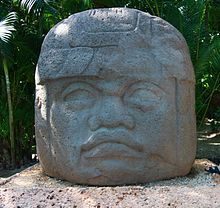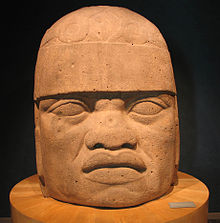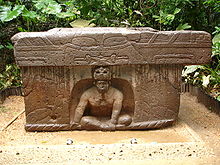Olmecs
As Olmec (from Nahuatl singular Ōlmēcatl or plural Ōlmēcah for "people of the rubber country ") were purchased from archaeologists , the support of the Mesoamerican La Venta -Culture referred. Their actual ethnicity is unknown. The culture of the Olmecs is from around 1500 to around 400 BC. Traceable along the coast of the Gulf of Mexico . Her most famous cultural legacies are several colossal heads . Whether the Olmec culture can be regarded as a Proto-Maya culture has been discussed many times, but is rather unlikely due to the great temporal and spatial distance.
Naming
On the south coast of the Gulf of Mexico, archaeologists uncovered sites of an early culture in the 1920s, which existed from the beginning to the middle of the first millennium BC. BC flourished in the sites of La Venta, San Lorenzo Tenochtitlan and Tres Zapotes . It is unknown how the bearers of this culture called themselves or were called by their contemporaries. At the time of the Aztecs (14th to early 16th century AD), i.e. 2500 years later, this landscape was inhabited by a people that the Aztecs called Huixtotin-Olmecs . Marshall Howard Saville , director of the Museum of the American Indian (Heye Foundation) in New York, first applied this name to the culture of the sites mentioned in 1929 . However, there is no evidence that the Aztec Olmec people were actually the descendants of the people who created the so-called "Olmec culture" centuries earlier.
history
Their centers were in what is now La Venta, Tres Zapotes and San Lorenzo Tenochtitlan on the southern Gulf coast of Mexico in what is now the states of Tabasco and Veracruz . The high rainfall in this area enabled them to cultivate maize intensively all year round . However, the origins of their culture can possibly be found in the Mexican highlands (Guerrero) and date back to around 1500 BC. BC back. Around 400 BC The last important Olmec centers were destroyed.
The Olmec people were probably gradually displaced by the younger, emerging Mayan culture and eventually completely absorbed by it.
Arts and Culture
The Olmecs were often seen as the bearers of the mother culture of Mesoamerica. The beginnings of writing and calendar calculation as well as the ball game and the erection of temple pyramids in America are attributed to them. The culture radiated into the later cultures of the Maya in the east and the Zapotecs in the west. The discussion about the mother culture has since subsided, however, as there is insufficient evidence that the Olmecs actually brought a large area under their rule. Due to iconographic similarities across large parts of Mesoamerica (cf. Monte Alto culture ), however, trade relations can be assumed that also spread representational conventions. Although metal tools were unknown to them, the Olmecs are considered masters of stone-working . They created excellent large sculptures in the form of the famous colossal heads as well as a wide range of small sculptures: altars, human and zoomorphic figures as well as objects made of obsidian and jade . As a typical motif here again and again the so-called were-jaguar (also Werjaguar ) whose shape features of a man and a jaguar connects.
The meter-high colossal heads of the Olmecs are made from volcanic bombs or blocks that come from the area of the Sierra de los Tuxtlas . All heads wear a more or less ornate cap-like headgear; sometimes the ear lobes are pierced with stakes and the hair is tied in small braids. It is believed that these realistically and unidealized heads are portraits of actual rulers, warriors or other important personalities.
Reception, art and film
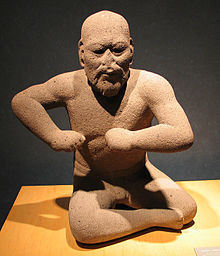
Because of the volcanic origin of their material, the colossal heads were interpreted by some artists as the children of a volcanic, fire-preserving earth mother goddess and thus seen as evidence of a matrix-centric religious culture. The physiognomy of the heads was occasionally interpreted as a mixture of negroid (lips and nose) and Asian (eyes) facial features, which became the basis of various speculative theories of origin of the Olmecs. There is no scientific evidence of this, and ethnological researchers have repeatedly made it clear that the appearance of the heads corresponds exactly to that of today's native population of the region.
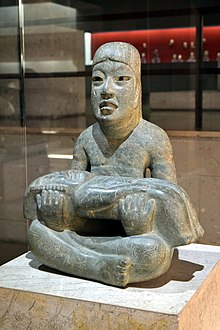
In the 1940s, the mysterious qualities led to a lively reception among artists and cultural philosophers. The Mexican artist and ethnologist José Miguel Covarrubias and his friend, the surrealist artist, theoretician and matriarchal researcher Wolfgang Paalen, were among the first interpreters of Olmec culture . In 1946, the American anthropologist had Matthew Stirling commissioned by the Smithsonian between San Lorenzo and Tenochtitlan five unearthed more of those strange colossal heads of the Olmecs, like from the sky fallen, childlike Buddha were right in the marshy ground of the forest without hulls, limb, or even signs of a architectural context, surrounded solely by numerous small sculptures made of obsidian and jade , in which the most dangerous, unpredictable and most deadly animal of the jungle was depicted again and again: the jaguar . As early as 1944, two years before the discoveries of Sterling, Covarrubias described in Paalen magazine Dyn No 6 the thesis developed by both of a final cultural war with an iconoclastic character: “Perhaps the elite of an old and proud Jaguar people (...) became isolated from La Venta ousted as waves of newcomers broke into their area, people of a different race and religion, snake worshipers who could not stand the people of the jaguar. (...) Perhaps La Venta was the last bastion of this ancient culture. (...) Its sudden end may have occurred when there was a religious or political clash between these peoples, the elementary, legendary feud that appears again and again in Mexican mythology. Most of the monuments are so battered that nothing can be seen. (...) Only the fanaticism of religious reformers can stand behind such a destruction of works of art. "
The alleged relationship to the ancient Chinese jade centers of the Xia and Shang dynasties (2200–1100 BC), in which the worship of the white jade stone as a symbol of life force was combined with the Taoist doctrines of balance and the whole of social equilibrium, gave rise to many questions Permeated life. "Stirling found the richest jade treasures in La Venta," wrote Wolfgang Paalen, "that have ever been discovered in America. (...)" The magical powers of heaven and earth are always linked to achieve perfect results; see above the pure substances of the hill and the water solidified to form precious jade. «This sentence from the speech of T'ang Yung Tao about jade would have been appreciated in precortesian Mexico, where jade (or jadeite) is the sacred stone par excellence and its name was synonymous with everything precious and divine. Just as the ancient Chinese put jade cicadas in the mouths of their dead, the Mexicans used jade beads for the same purpose. "
In February 1945 Wolfgang Paalen set off from Veracruz by boat up the Rio Chiquito to the difficult-to-reach village of San Lorenzo Tenochtitlán , in order to penetrate the inaccessible area of the Olmecs from there. Enthusiastic he fights his way through the jungle meter by meter, suspecting architectural remains of huge, submerged cities behind every regular elevation, on the steep slope of a deep rocky gorge he finally comes across the "most monumental head discovered so far. He lies there in all its abandoned grandeur, completely exposed to the elements, in the wide-open eyes the reflection of an ancient cosmic wisdom. His face, one of the most majestic that man has ever created, and the noblest of his princely brothers, has a cloudy, youthful and powerful forehead and above a firm, The rounded chin completes a sensitive, delicately rounded mouth. " Paalen was verifiably the first ethnological researcher who suspected the cause of the disappearance of the Olmecs to be a conflict with a slowly emerging, strongly patriarchal cultural system with a religion geared towards death, before which the older life culture with its on the birth processes of a volcanic earth mother goddess oriented tendency finally had to capitulate after centuries of war. Everywhere in the jungle Paalen encountered evidence of a process that allows patriarchy to emerge from the natural balance. It is generated from the armed attack on peaceful villages, from their capture, looting and subsequent destruction, as a result of which public killings, the fear and enthusiasm that this triggers in the masses can strengthen the subjugation of the people. The feminine is symbolically desecrated so that women can be humiliated and marginalized in the new system: the origin of the antagonism of the sexes, the power that legitimizes itself from the stolen property. Even in peacetime, the war continues in a thousand steps inside the people and the new state structure. This theory, which was undoubtedly inflated in relation to the time, was subsequently repeatedly disputed, but could never be refuted.
Modern research suggests socio-cultural connections with the even older culture of the Arawak , whose northernmost foothills on the Antilles were met by Columbus and which he described as peace-loving and exceptionally hospitable. The South American Arawak, who were enslaved and almost completely exterminated under Spanish rule, lived in matrilineal clans until the end and possessed a complex mythology of jaguars, earth and moon mother goddesses.
Paalen's thesis of a historically explainable dichotomy of matrilineal and patriarchal social structures in Mesoamerica lives on in scientific discourses to this day as well as in the imagination of many artists and authors. The best-known example is Mel Gibson's cinematic major work Apocalypto , in which the story of the chief's son, Paw the Jaguar , is told, who lives peacefully in the jungle with his villagers - in a cheerful, reproductive gender balance and completely adapted to wild life. One day brutal Mayan death squads appear, murderous and pillaging through the rainforest and pick up the surviving men in order to sacrifice them to the god Kukulcán in massive mass ceremonies after a week-long march to the pyramids . On the way, the prisoners witness the devastating destruction of nature caused by the new state structure. Before its capture, the jaguar's paw had managed to hide its pregnant wife in a hole in the ground. Seriously injured, he escapes through an indomitable will to live, cunning and knowledge of the healing powers of the jungle plants, finds his wife again, who has meanwhile given birth to a child in the rainwater-flooded hole in the ground, and escapes with her to the coast, where he witnesses the next, this time final threat will be the ships of the Spanish conquerors.
font
In 2003 it appeared in San Andrés on the Mexican Gulf coast to about 650 BC. Olmec cylinder seal dated BC with written symbols. However, most scientists don't see it as a real script yet .
However, as early as 1999, near the village of Cascajal (north of San Lorenzo), an inscribed stone block was found by chance during road construction work. It was only in 2006 that it turned out that this so-called Cascajal stone depicts the oldest glyphs in the New World to date . According to the findings of the archaeologists around Carmen Rodríguez Martínez and Ponciano Ortíz Ceballos from the Instituto Nacional de Antropología e Historia , the glyphs are an unknown Olmec writing system that dates back to around 900 BC. And has all the characteristics of a real writing system. The scientists even want to have recognized bound language in it. The stone's 62 glyphs consist of 28 different characters. The 12 kg Cascajal stone is made of serpentine and is 36 × 31 × 13 cm in size. The face of the stone is concave ; this points to the previously unique technology that writing was chipped off several times and the stone was rewritten.
mythology
Unlike the Maya , the Olmecs left no documents of their mythology behind; in other words: images of gods are missing. That is why the interpretation of their ideas is based on the ruins of their monuments and on comparisons with other Mesoamerican cultures and analogous conclusions. What is certain, however, is that they influenced the later civilizations of pre-Columbian Mesoamerica to a great extent.
See also
Finds related to the art of the Olmecs are shown in:
- National Museum of Anthropology (Mexico)
- Museo de Antropología de Xalapa
- Parque-Museo La Venta ( Villahermosa )
- Museum of the San Lorenzo Tenochtitlan site
- Tres Zapotes Site Museum
literature
- Norman Bancroft-Hunt: Atlas of the Indian high cultures - Olmec, Toltec, Maya, Aztec. Tosa-Verl., Vienna 2002, ISBN 3-85492-557-3 .
- John E. Clark: Olmec art and archeology in Mesoamerica. Yale Univ. Pr., New Haven 2000, ISBN 0-300-08522-2 .
- Richard A. Diehl: The Olmecs - America's first civilization. Thames & Hudson, London 2004, ISBN 0-500-02119-8 .
- Harald Haarmann : Lexicon of the lost peoples - from Akkadians to Zimbri. Beck, Munich 2005, ISBN 3-406-52817-1 . Pp. 208-209
- Ulrich Köhler: Olmecs and Jaguars. On the interpretation of hybrid beings in the pre-classical art of Mesoamerica. In: "Anthropos", 80: 15-52 (1985).
- Henri Stierlin: The Art of the Maya - from the Olmecs to the Maya-Toltecs. Belser, Stuttgart 1997, ISBN 3-7630-2348-8 .
- Dieter Struss: The large picture atlas of archeology. Orbis Verl., Munich 1991, ISBN 3-572-01022-5 .
Web links
- Literature about the Olmecs in the catalog of the Ibero-American Institute in Berlin
- Olmec culture - photos, drawings + information
- Stone heads of the Olmecs - photos, drawings + info (English)
- Newspaper article on the Cascajal stone
- Olmec depictions of birds and plants with special consideration of references to depictions of drugs - Dissertation (pdf; 9.46 MB)
- Olmecs - photos + information
- Early Olmec art
Individual evidence
- ↑ Bildatlas der Aräologie, p. 344.
- ↑ Origin of the Olmec literature
- ↑ z. B. Wolfgang Paalen, Un Visite au Vulcan , in: DYN 4-5 (Amerindian Number), Mexico 1943, p. 72; Birth of Fire, A mythological Hypothesis suggested by the Appearance of a New Volcano , p. 71ff. Paalen's thesis, developed here, that the pyramid of the sun in Teotihuacan was the work of an earlier, matricentric culture, whose cult activities are connected with the volcano as the birth opening of the earth mother, always found itself in the course of time through reports about its original painting with jaguars and magna-mater depictions greater evidence. In 2011 an Olmec jade figure was found during excavations under the pyramid, which could prove the influence that the Olmecs as mother culture had on the Mayan and Aztecs that followed.
- ^ Polyglott Apa Guide Mexico , page 29. ISBN 3-8268-1936-5
- ↑ Miguel Covarrubias, La Venta, Colossal Heads and Jaguar Gods, in: DYN 6, Mexico 1944, pp. 24f.
- ^ WP, Le plus ancien visage du Nouveau Monde, in: Cahiers d´Art, Paris 1952, quoted after. German Translated by Walter Becker, in: Andreas Neufert, Inside the Wals, Vienna New York (Springer), 1999, p. 264
- ↑ ibid
- ↑ after Howard Zinn, A People's History of the United States, Harper Perennial, 2005, p. 3
- ↑ Heide Göttner-Abendroth, Das Matriarchat II, 2, Tribal Societies in America, India, Africa, Stuttgart (Kohlhammer) 2000, p. 15ff.
- ^ Science . Washington DC 298.2002 (dated December 6, 2002). ISSN 0036-8075
- ↑ When Americans learned to write.
- ^ Katja Seefeldt: Enigmatic characters.
- ^ Maria del Carmen Rodriguez Martinez (Centro del Instituto Nacional de Antropologia e Historia, Veracruz) among others in: Science . Washington DC 313.2006, p. 1610. ISSN 0036-8075


